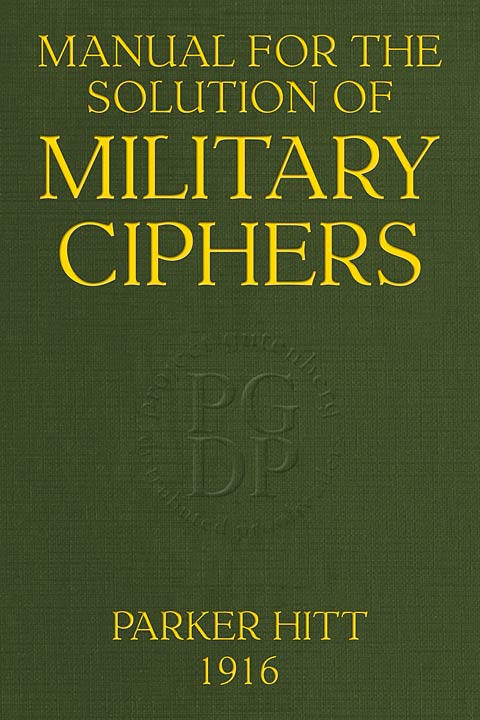

THE ARMY SERVICE SCHOOLS
Fort Leavenworth, Kansas
1916
[v]
MANUAL FOR THE SOLUTION
OF MILITARY CIPHERS
BY
PARKER HITT
Captain of Infantry, United States Army
Introduction
The historyof war teems with occasions where the interception of dispatches andorders written in plain language has resulted in defeat and disasterfor the force whose intentions thus became known at once to the enemy.For this reason, prudent generals have used cipher and code messagesfrom time immemorial. The necessity for exact expression of ideaspractically excludes the use of codes for military work although it ispossible that a special tactical code might be useful for preparationof tactical orders.
It is necessary therefore to fall back on ciphers forgeneral military work if secrecy of communication is to be fairly wellassured. It may as well be stated here that no practicable militarycipher is mathematically indecipherable if intercepted; the most thatcan be expected is to delay for a longer or shorter time thedeciphering of the message by the interceptor.
The capture of messengers is no longer the only meansavailable to the enemy for gaining information as to the plans of acommander. All radio messages sent out can be copied at hostilestations within radio range. If the enemy can get a fine wire withinone hundred feet of a buzzer line or within thirty feet of a telegraphline, the message can be copied by induction. Messages passing overcommercial telegraph lines, and even over military lines, can be copiedby spies in the offices. On telegraph lines of a permanent nature it ispossible to install high speed automatic sending and receiving machinesand thus prevent surreptitious copying of messages, but nothing but asecure cipher will serve with other means of communication.[vi]
It is not alone the body of the message which should bein cipher. It is equally important that, during transmission, thepreamble, place from, date, address and signature be enciphered; butthis should be done by the sending operator and these parts must, ofcourse, be deciphered by the receiving operator before delivery. Aspecial operators’ cipher should be used for this purpose but itis difficult to prescribe one that would be simple enough for theaverage operator, fast and yet reasonably safe. Some form of rotarycipher machine would seem to be best suited for this